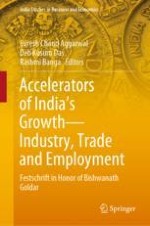2020 | OriginalPaper | Chapter
Technology, Jobs and Inequality: Evidence from India’s Manufacturing Sector
Author : Radhicka Kapoor
Published in: Accelerators of India's Growth—Industry, Trade and Employment
Publisher: Springer Singapore
Activate our intelligent search to find suitable subject content or patents.
Select sections of text to find matching patents with Artificial Intelligence. powered by
Select sections of text to find additional relevant content using AI-assisted search. powered by
